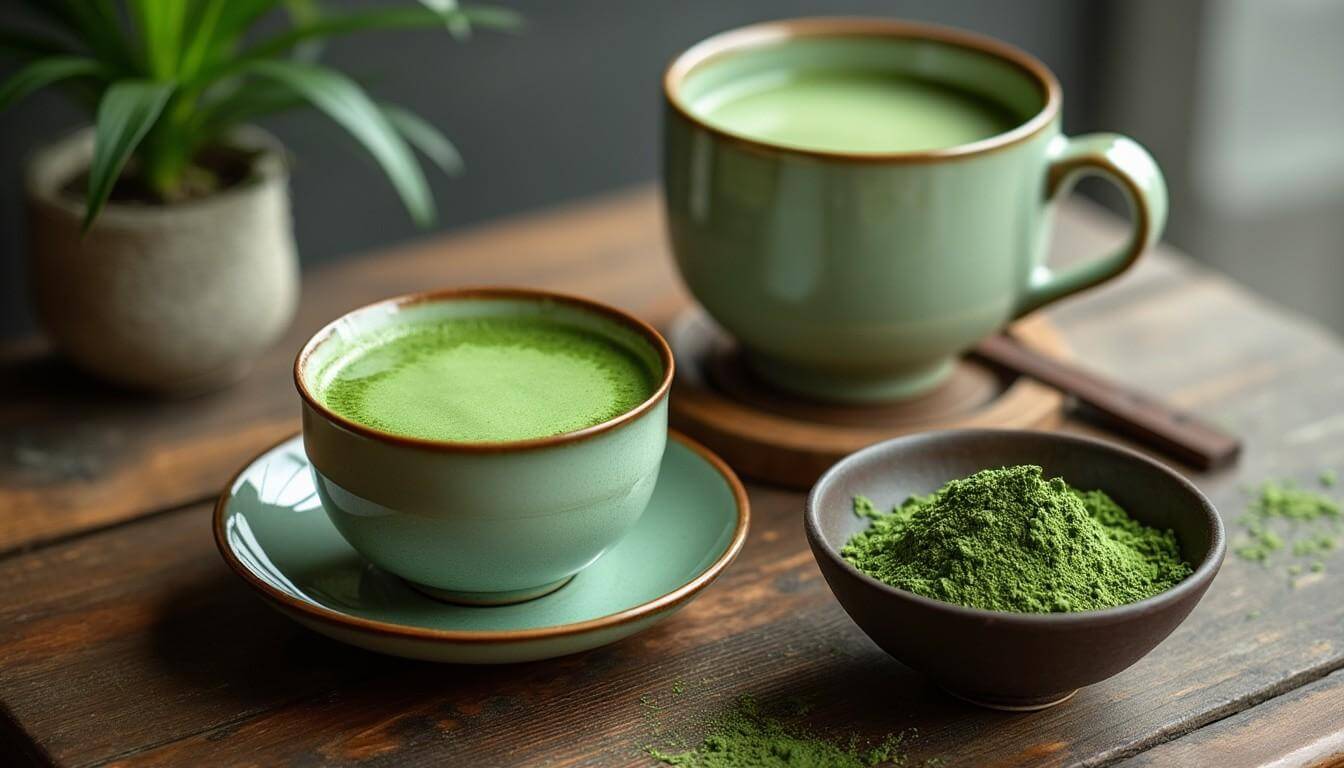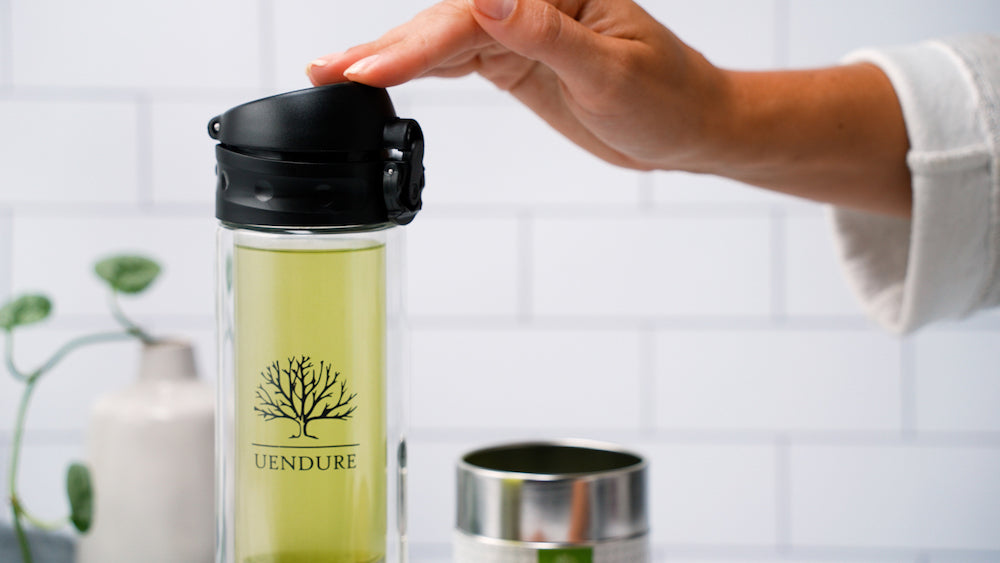Save 15% when you buy the Original Bottle Bundle!

When it comes to Japanese tea, the terms ryokucha and matcha can be confusin. Ryokucha, which translates to green tea, serves as an umbrella term for all the different types of Japanese green teas, including sencha, hojicha, and the famed matcha.
Shop our collection of green teas
Matcha, on the other hand, is a specific type of green tea. It stands out from other green teas due to its powdered form and ceremonial significance. Matcha is made from shade-grown leaves that are carefully processed and ground into a fine powder.
Getting To Know Ryokucha and Matcha
Ryokucha and matcha represent two significant aspects of Japanese tea culture.
Origin and History of Ryokucha
Ryokucha has its roots in Japan. The introduction of green tea occurred in the early 9th century, influenced by Chinese tea culture. By the 12th century, the cultivation of various types of ryokucha began in Japan, particularly from the tea plant Camellia sinensis. Distinct processing methods, such as steaming leaves to halt fermentation, contribute to the unique flavors of ryokucha varieties like sencha, gyokuro, and hojicha. Each type embodies different regional influences and brewing techniques, making ryokucha an essential part of Japanese daily life. Today, it's the most consumed tea in Japan, celebrating a rich tradition that persists through generations.
Origin and History of Matcha
Matcha's origins trace back to 12th-century China, where ground tea leaves became a common preparation method. Japanese Buddhist monk Eisai introduced this practice to Japan after observing it during his travels. Upon arrival, he brought tea seeds and the practice of whisking powdered tea into hot water. Over time, matcha evolved into a distinct form of tea, characterized by its shade-grown cultivation and unique flavor profile. In the mid-1500s, the development of shading techniques refined matcha, leading to the modern preparation that is central to the Japanese tea ceremony. Matcha gained prominence as both a beverage and an art form, embodying Japan’s cultural values of harmony and respect.
Differences in Production Methods
Ryokucha and matcha differ significantly in their production methods, affecting their flavor profiles and overall quality.
Leaf Selection and Processing
Matcha uses specifically selected young tea leaves known as tencha, which undergo a rigorous shading process for three weeks prior to harvest. This shading enhances the leaves' umami flavor and reduces bitterness, creating a more refined taste. Farmers experienced in this traditional practice ensure that only high-quality leaves are used.
In contrast, ryokucha incorporates a wider range of leaves, including those from older plants. The processing for ryokucha may involve steaming or pan-frying the leaves, which halts fermentation and preserves their green color. This method results in various types of ryokucha, such as sencha and hojicha, each with distinct flavor profiles based on the leaves' exposure to sunlight and their age.
Grinding Process for Matcha
Matcha requires a specific grinding process to achieve its fine powder form. A traditional stone mill grinds the leaves slowly, preventing heat that could compromise the delicate flavors. This meticulous method produces a smooth, vibrant green powder essential for high-quality matcha. Faster grinding methods yield a product that doesn't qualify as true matcha due to the heat's impact on taste.
Ryokucha, lacking this grinding requirement, is typically brewed whole leaves rather than ground. The steaming or roasting process used in ryokucha production solidifies its status as whole leaf tea, with its flavors expressed through steeping rather than grinding. The distinctions in production methods play a crucial role in defining the characteristics and enjoyment of these two renowned teas.
Nutritional Profiles
Ryokucha and matcha offer distinctive nutritional profiles that contribute to their health benefits.
Health Benefits of Ryokucha
Ryokucha, particularly sencha and gyokuro, contains high levels of catechins, a type of antioxidant known for their fat-burning properties. Catechins lower cholesterol levels, support heart health, and enhance overall wellness. Ryokucha also provides vitamins C and E which boost the immune system and promote skin health. Additionally, the amino acids found in ryokucha, like theanine, foster relaxation and improve mood.
Health Benefits of Matcha
Matcha's nutritional profile stands out due to its concentrated form. Since matcha is made from whole tea leaves, it contains higher levels of catechins compared to other green teas. These antioxidants help lower blood pressure and enhance metabolic rates, assisting in weight management. Matcha also contains a significant amount of theanine, which promotes relaxation without drowsiness, supporting mental clarity and focus. The vitamin C in matcha bolsters the immune system and supports skin maintenance, maximizing its health benefits.
Flavor Profiles and Brewing Techniques
Exploring the flavor profiles and brewing techniques of ryokucha and matcha reveals a rich tapestry of tastes and traditions unique to Japanese tea culture.
Taste Characteristics of Ryokucha
Sencha, the most common ryokucha, offers a light, sweet flavor with refreshing notes. Gyokuro, known for its high quality, presents a rich umami taste, complemented by a subtle sweetness, thanks to its extended shading during growth. Kabusecha, which falls between gyokuro and sencha, combines the sweet profile with a refreshing taste. Overall, ryokucha is characterized by its fresh, green flavor and a wide spectrum of vegetal notes, making it versatile for different palates.
Taste Characteristics of Matcha
Matcha stands out for its distinct taste, which balances bitterness with a rich, creamy sweetness. The shading process enhances its umami flavor, making higher grades more delicate and floral, while lower grades tend to have a stronger, more robust taste. Matcha's flavor profile ranges from vegetal to floral notes and is often described as earthy. The unique production method contributes to a smooth, rich mouthfeel, making each sip a complex experience tailored to individual preferences.
Brewing Methods for Ryokucha
Brewing ryokucha requires attention to temperature and steeping time to unlock its flavors. Sencha is typically brewed at around 70ºC (158ºF) for about one to two minutes. Gyokuro, needing a lower temperature of 55ºC (130ºF), is steeped for 2 to 3 minutes to preserve its rich umami. Kabusecha is brewed similarly to sencha but at a slightly higher temperature of around 70ºC (158ºF) for two minutes. Each variety offers a distinct flavor experience based on these specific brewing techniques, allowing tea drinkers to explore the depth of ryokucha.
Brewing Methods for Matcha
Matcha preparation differs significantly from conventional tea brewing. To make matcha, I'll use a small amount of water, typically 60 to 70 ml (2 to 2.4 oz), combined with 1 to 2 teaspoons (2 to 4 grams) of matcha powder. Whisking the mixture creates a frothy consistency, resembling an espresso in strength. The careful process of whisking ensures an even dispersion of the powder, allowing the rich flavors and aromas to emerge. This method highlights the vibrant, grassy notes of matcha, making it both a ceremonial drink and a flavorful experience.
Cultural Significance
Cultural practices surrounding ryokucha and matcha reflect the deep-rooted traditions of Japanese society. These teas hold unique values that transcend mere consumption, illustrating connections to ritual, social interaction, and artistry.
Role of Ryokucha in Japanese Tea Culture
Ryokucha serves as an everyday staple in Japanese households. This versatile tea invites social gatherings, enhancing the enjoyment of meals or simple companionship. Sencha, the most popular type of ryokucha, often accompanies traditional Japanese dishes, providing a refreshing complement to the food's flavors. In various regions, ryokucha represents local identity, with distinct varieties reflecting the climate and soil. Through everyday consumption and hospitality, ryokucha embodies Japanese values of mindfulness, health, and appreciation for nature.
Role of Matcha in Traditional Ceremonies
Matcha gains significance through its central place in the Japanese tea ceremony, known as sado or chanoyu. This elaborate ritual emphasizes harmony, respect, purity, and tranquility, reflecting vital aspects of Japanese aesthetics. In the ceremony, matcha preparation involves precise movements, meticulous attention to detail, and a deep sense of presence. The act of whisking matcha into a frothy beverage becomes an art form, allowing participants to engage with the moment on a personal level. Beyond its aesthetic value, matcha fosters community and connection, with guests and hosts sharing a profound experience that transcends verbal communication.
Conclusion
Choosing between ryokucha and matcha ultimately depends on personal preference and the experience you seek. Ryokucha offers a variety of flavors and is perfect for everyday enjoyment. Its rich history and cultural significance make it a staple in Japanese life.
Matcha, with its vibrant green powder and ceremonial roots, provides a unique experience that emphasizes mindfulness and connection. Its concentrated nutrients and distinct taste make it a favorite for those looking for a health boost.
Both teas invite exploration and appreciation of their unique qualities. Whether you're sipping a cup of ryokucha or whisking up matcha, each offers a delightful journey into Japan's rich tea culture.



There is so much goodness in matcha beyond the flavor. I love creating matcha lattes with bananas…Yum!